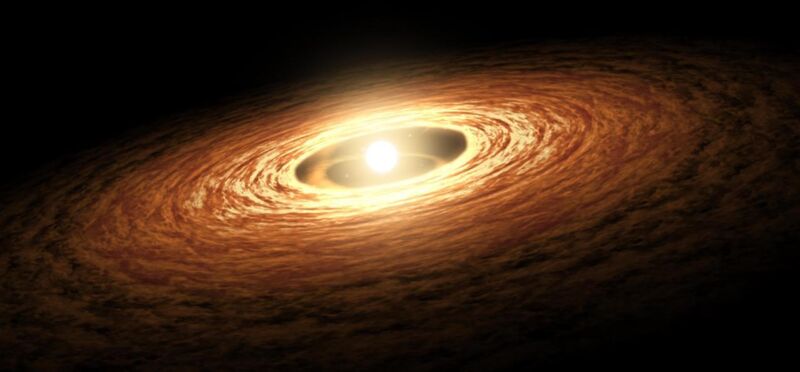Stars are thought to form within enormous filaments of molecular gas. Regions where one or more of these filaments meet, known as hubs, are where massive stars form.
These massive stars, located nearby, would have put the early Solar System at risk of a powerful supernova. This risk is more than just hypothetical; a research team at the National Astronomical Observatory of Japan, led by astrophysicist Doris Arzoumanian, looked at isotopes found in ancient meteorites, finding possible evidence of a massive star’s turbulent death.
So why did the Solar System survive? The gas within the filament seems to be able to protect it from the supernova and its onslaught of radioactive isotopes. “The host filament can shield the young Solar System from stellar feedback, both during the formation and evolution of stars (stellar outflow, wind, and radiation) and at the end of their lives (supernovae),” Arzoumanian and her team said in a study recently published in The Astrophysical Journal Letters.
Signs of a supernova
The meteorites studied by the researchers contained small inclusions, or lumps within the rock, about as old as the Solar System. These lumps contain isotopes derived from the decay of short-lived radionuclides (SLRs), which can be generated by supernovae. Even though SLRs decay after a few hundred million years, which is nothing in cosmic terms, they do leave behind distinctive isotopes.
The team detected an especially high level of isotopes from SLRs in the meteorites they examined. From the age of the isotopes, they could infer that the SLRs they once belonged to were present in the early Solar System. Supernovae are one SLR source, which might mean our Solar System dodged a supernova, although there are other ways they can form.
SLRs from the interstellar medium might already be floating around in the molecular cloud a star forms in. The birth of massive stars, which do not live that long (at least in cosmic terms) and quickly die via supernova, can be another source, as can isotopes produced by highly energetic solar or galactic cosmic rays. Any of these sources can possibly explain the existence of SLRs in the early Solar System,
While SLRs probably existed in the part of the filament where the Sun and Solar System formed, the meteorite samples contained too much of a particular aluminum isotope for the interstellar medium to have been the Solar System’s only SLR source. Cosmic rays, which can convert stable isotopes to radioactive ones, had a better chance of explaining the number of isotopes found in the meteorites. However, it would have taken too long for this process to produce the levels of SLRs found in the early Solar System.
It is most likely that such high SLR levels could have come from either very intense stellar winds, which would have occurred during massive star formation, or from what was left after one of the massive stars went supernova.
Protection
So why didn’t the supernova disrupt the Solar System? It appears the destructive blow was softened by the molecular gasses of the filament in which the Sun formed. If the isotopes from those long-decayed SLRs were really from a supernova or stellar winds, the amount that made it through the filament gas was enough to match what was suggested by the meteorite findings but not enough to decimate the Solar System. The size of this hypothetical supernova or newborn star is still unknown.
“This scenario may have multiple important implications in our understanding of the formation, evolution, and properties of stellar systems,” the researchers also said in the study.
Though there are still some unanswered questions, the scientists suspect that if the clouds of the filament the Sun and Solar System formed in were sufficiently large, our star and planets would have easily survived being slammed by a supernova.
The Astrophysical Journal Letters, 2023. DOI: 10.3847/2041-8213/acc849 (About DOIs).



3175x175(CURRENT).thumb.jpg.b05acc060982b36f5891ba728e6d953c.jpg)
Recommended Comments
There are no comments to display.
Join the conversation
You can post now and register later. If you have an account, sign in now to post with your account.
Note: Your post will require moderator approval before it will be visible.